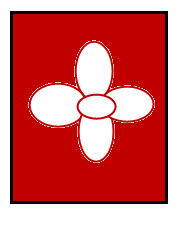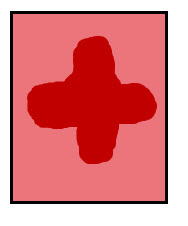Natures Natural Sunblockers
Some of the organisms in the icy waters of the Antarctic Ocean have a natural sun-blocker. What is this substance?
Answer:
Pigments (coloring substances) in living organisms, such as melanin in human skin, can also protect them from UVL. The young girl on the left in the picture above has very little skin pigment, while the child on the right has a lot of skin pigment. The more skin pigment the darker is the skin, and the more protected is the skin from sunlight.
It is believed that the Antarctic phytoplankton (small, often microscopic plant-like organisms that are capable of producing food by using light) may have the capacity to adapt to increased amounts of ultraviolet radiation by producing their own sun-block pigments.
Model the affect of the pigment in the Antarctic phytoplankton.
 1. Draw a shape, such as a flower, as large as possible on a 4 x 4 inch (10 x 10 cm) piece of white poster board. Cut out the shape.
1. Draw a shape, such as a flower, as large as possible on a 4 x 4 inch (10 x 10 cm) piece of white poster board. Cut out the shape.
2. Place the poster board shape in the center of a red sheet of construction paper. Tape the edges of the shape to the paper to hold it in place.
3. Tape the red paper to a window that received direct sunlight. The flower on the paper should be against the window glass. (You could tape the paper, flower side up on an outdoor flat surface that receives direct sunlight.)
4. The paper taped to the window could be checked daily for two or more days. When check, carefully lift the edge of the flower pattern to determine if there is any difference between the color of the paper under the flower and the paper not covered by the flower. (If the paper is placed outdoors, you should bring it indoors at the end of the day and check the color as previously described. You may wish to return the paper to its outdoor position again if the coloring has no obvious change.)
 Results: The color of the paper under the flower design remains red while the paper not covered by the paper flower is pink. This is because the paper flower pattern is opaque (doesn’t allow light to pass through). Thus, the flower cut from poster board, like pigment in phytoplankton acts as a sun-block. The paper flower preventing the sun’s light from hitting the red paper. Being white, the paper flower absorbs some of the energy from the sunlight that strikes it, but most of the light is reflected.
Results: The color of the paper under the flower design remains red while the paper not covered by the paper flower is pink. This is because the paper flower pattern is opaque (doesn’t allow light to pass through). Thus, the flower cut from poster board, like pigment in phytoplankton acts as a sun-block. The paper flower preventing the sun’s light from hitting the red paper. Being white, the paper flower absorbs some of the energy from the sunlight that strikes it, but most of the light is reflected.
In the skin of organisms, melanin is a dark pigment that absorbs harmful UV-radiation from sunlight and transforms the UV energy into harmless amounts of heat.
 |
Ecology Science |
